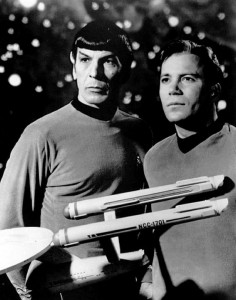 The original Star Trek television series is celebrating its 50th anniversary so I have been thinking about some of the technologies they depicted that have become reality. Unfortunately, we still are not able to beam each other through space, but some of our current devices and applications have already surpassed the imagination of science fiction writers.
The original Star Trek television series is celebrating its 50th anniversary so I have been thinking about some of the technologies they depicted that have become reality. Unfortunately, we still are not able to beam each other through space, but some of our current devices and applications have already surpassed the imagination of science fiction writers.
Set Phasers to Stun
In the TV series and the movies, characters always carried a phaser, particularly when they were exploring new worlds. This device had different settings and worked presumably by emitting a phased particle beam to either stun, freeze, or kill their opponent. Our equivalent is the taser, which I highlighted in a recent blog on law enforcement technology. It is different in that you need to make physical contact and it will only stun and not kill, except in rare cases. There is news that scientists are working on a real-life phaser, but that may just be wishful thinking from Star Trek fans.
Communicators
This is an area where I think we have surpassed the writers’ imagination. In the original Star Trek television series the characters used a cell phone type device to talk to another person on the ship. Nextel developed something similar in 1996 with their push to talk service over a standard cell phone. In subsequent franchises, the crew needed only to touch the logo on their uniform and they could start communicating. Fast-forward to 2016 when people walk down the street seemingly talking to themselves while communicating with someone not just on the proverbial ship, but possibly in a foreign country. How far we have come from the mythical communicator of 1966.
Telepresence
In the TV shows, the characters could communicate with each other via a telepresence video screen. They could even communicate with alien ships if their systems were compatible. Video communications were fairly foreign in 1966 but I think we now take it for granted. I was fortunate to be part of a pilot for HP’s Halo teleconferencing systems, now part of Polycom. The aim was to create identical rooms so that it appeared that your colleagues in Tokyo were just across the table from you. Now video communications have come to the smart phone through Skype, Google Hangouts, FaceTime, or Tango. That means our version of the communicator not only lets us speak to each other but also lets us do full video conferencing. Take that Captain Kirk.
Universal Language Translator
In a large universe it is necessary to be able to translate between many different languages. The crew of the USS Enterprise had a universal language translator they used to communicate with alien cultures. It somehow could translate any language. Our version is a bit more limited in the number of languages and I don’t think it currently translates Vulcan. Voice translator apps for smart phones are still in their infancy but work fairly well for about 50 languages. They feature speech to text or text to speech, and some have the ability to use the camera to capture and translate an image such as a road sign. I am excited about a new earpiece in development from Waverly Labs that allows you to hear and translate a foreign language. They are taking pre-orders now through Indiegogo.
Thoughts
Science fiction series such as Star Trek are a great catalyst for spurring our imagination about technology. An anniversary event is a great opportunity to reflect on our progress. Are there other Star Trek devices that we have already nailed? Let me know your thoughts.
Kelly Brown is an IT professional and assistant professor of practice for the UO Applied Information Management Master’s Degree Program. He writes about IT and business topics that keep him up at night.

